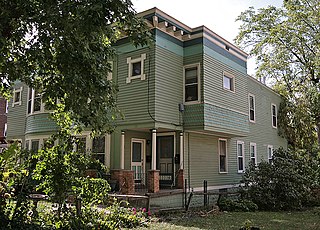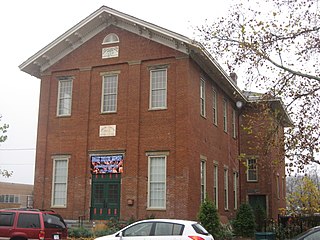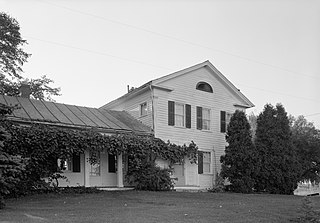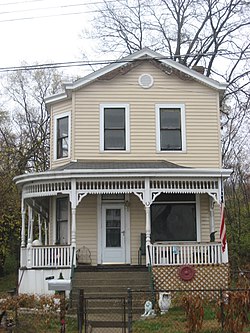
The Bates Building is a historic house in the Columbia-Tusculum neighborhood of Cincinnati, Ohio, United States. A two-story building constructed in a vernacular style of architecture, it is one of the oldest buildings on Eastern Avenue in the neighborhood.

The Jacob Bromwell House is a historic residence in the city of Wyoming, Ohio, United States. An Italianate house constructed in the late nineteenth century, it was originally the home of a U.S. Representative, and it has been designated a historic site.

The Stephen Decker Rowhouse is a historic multiple residence in the Columbia-Tusculum neighborhood of Cincinnati, Ohio, United States. Built in 1889, it occupies land that was originally a portion of the wide vineyards of Nicholas Longworth. In 1869, after his death, Longworth's estate was platted and sold to builders who constructed a residential neighborhood along Tusculum Avenue. One of the most unusual buildings was the Decker rowhouse, which features multiple distinctive Victorian elements. Chief among these is the ornamentation on the porch roofs: they include gabled rooflines and beveled corners supported by multiple spindles. Connecting these porch roofs are low normal roofs, which primarily protect the recessed entrances to the houses. Elsewhere, the houses feature double-hung windows, imbricated shingles on the gables, and arcades of Gothic Revival panelling, and numerous ornamental circles inscribed within squares. Taken as a single building, the rowhouse measures two bays wide and eighteen bays long; it is of frame construction and two stories tall. Rated "outstanding" by an architectural survey in 1978, it is the only rowhouse of its type in Cincinnati, due to its well-preserved Victorian architecture.

The Charles Fay House is a historic residence in the city of Wyoming, Ohio, United States. Erected in the late nineteenth century, it was originally the home of one of the city's leading educators, and it has been designated a historic site because of its distinctive architecture.

The Elmer Hess House is a historic residence in the city of Wyoming, Ohio, United States. Erected in the late nineteenth century, it was originally the home of a Cincinnati industrialist, and it has been designated a historic site because of its distinctive architecture.

The Hoodin Building was a historic apartment building in the Columbia-Tusculum neighborhood of Cincinnati, Ohio, United States. Built in 1881, it was once one of the neighborhood's most prestigious addresses. Despite its designation as a historic site, it is no longer standing.

The Kellogg House is a historic building in the Columbia-Tusculum neighborhood of Cincinnati, Ohio, United States. Built in 1835, it is a two-and-a-half-story building with two prominent chimneys on the ends. The weatherboarded walls rest on a stone foundation and are covered by a metal roof, which rises to a high gable on each end. The building's architecture is a mix of the Federal style with many vernacular elements; it has been recognized as one of the area's best examples of transitional architecture. Some of the distinctive features of the Kellogg Building are the small brackets that support the simple cornice, two wings attached to the rear, and the two enclosed porches on the facade. Inside, the main hallway is ornamented by such features as intricate fretwork and multiple pillars. Main hallway is also occupied by the homes original pipe organ.

The Landt Building is a historic house in the Columbia-Tusculum neighborhood of Cincinnati, Ohio, United States. Constructed at the end of the nineteenth century, it has been named one of the neighborhood's numerous historic sites.

The Mardot Antique Shop was a historic commercial building in the Columbia-Tusculum neighborhood of Cincinnati, Ohio, United States. Built in 1889, it was a weatherboarded structure with a slate roof and built on a stone foundation. Three stories tall, the building was a simple rectangle, two bays by three, and it featured a simple symmetrical facade with a cast iron front and many windows. Other architectural features included multiple dormers in the roof, a small cornice with brackets, and a recessed portion of the storefront surrounding the main entrance.

The Norwell Residence is a historic house in the Columbia-Tusculum neighborhood of Cincinnati, Ohio, United States. A Victorian building constructed in 1890, it is a weatherboarded structure with a stone foundation and a shingled roof. The overall floor plan of the house is irregular: two and half stories tall, the house is shaped like the letter "L" but appears to be a rectangle, due to the presence of two separate porches that fill in the remaining area. Many ornate details characterize it, including imbricated shingles on the westward-facing gable end of the house, a frieze with spindles on the railing of the primary porch, and small yet cunningly crafted braces for the same porch. Yet more distinctive is the secondary porch, which sits atop the primary one; it features braces and spindles similar to those of the primary porch.

The L.B. Robb Drugstore was a historic pharmacy in the Columbia-Tusculum neighborhood of Cincinnati, Ohio, United States. Erected in 1860, it was a four-story building, constructed of brick on a stone foundation and topped with a slate roof. The building was a simple rectangle in its floor plan, although not without embellishments: the roof, which rose to gables on the sides, was crowned by a large central chimney, while the gables were ornamented with machicolations, and the walls were anchored by brick pilasters. After the drugstore was completed, it was modified by the addition of a wooden porch to one of the sides; aside from the porch, it measured four bays on the front, four on the rear, and four on each side. The windows were of plain lintel construction with lugsills on the sides.

The Charles B. Russell House is a historic residence in the Clifton neighborhood of Cincinnati, Ohio, United States. Built in 1890, it is a large two-and-a-half-story house constructed primarily of limestone. Multiple windows, including several dormer windows, pierce all sides of the turret, while another large dormer window with Palladian influences is present on the house's southern side. A common theme in the design of the house's windows are string courses of stone that connect the windows and voussoirs that radiate out from the windows to many directions. Among its most distinctive architectural elements are the heavy stone front porch, which transitions from a verandah on one end to a sun porch on the other end, and the large circular turret on the front corner of the house, which is capped with a beehive-shaped pinnacle.

The Spencer Township Hall is a historic former government building in the Columbia-Tusculum neighborhood of Cincinnati, Ohio, United States. One of Cincinnati's oldest extant public buildings, it has been designated a historic site because of its architecture.

The Stites House is a historic residence in the Columbia-Tusculum neighborhood of Cincinnati, Ohio.

The Darlon Allen House is a historic residence located near Wellington in southern Lorain County, Ohio, United States. One of the most significant farmhouses in an area known for its historically important architecture, it has been named a historic site.

St. Louis Catholic Church is a historic Roman Catholic church in North Star, Ohio, United States. Constructed in the early twentieth century, it is one of the newest churches in a heavily Catholic region of far western Ohio, but it has been recognized as a historic site because of its unique architecture.

The John L. Nichols House is a historic former residence in Bloomington, Indiana, United States. Built in a late variety of the Victorian style of architecture, it was constructed in 1900. Once the home of Bloomington's leading architect, it is no longer a residence, but it has been designated a historic site.

The Alexander Thoirs House is the oldest surviving brick house in Wabasha, Minnesota, United States, and the earliest example of the brick merchant houses that characterized the city's 19th-century streetscape. It was built in two phases in 1868 and 1870 for a successful local shoemaker. The house was listed on the National Register of Historic Places in 1989 for having local significance in the theme of architecture. It was nominated for its status in the city's early housing stock, its fine Greek Revival architecture, and its embodiment of the success of Wabasha's early merchant class, which helped establish the city's own commercial importance.

Simons' Inn, also known more recently as Rowell's Inn, is a historic traveler's accommodation on Vermont Route 11 in Andover, Vermont. Built in 1826, it is a remarkably well-preserved example of a 19th-century stagecoach inn. It has for many years been a local community meeting point, serving as a general store and post office until 1950. It was listed on the National Register of Historic Places in 1979. It is now a private residence.

The Lorenz and Lugerde Ginthner House is a historic house in Wabasha, Minnesota, United States. Built in 1882 in high Italianate style on a prominent corner lot, it was listed on the National Register of Historic Places in 1989. It is particularly notable for its elaborate Italianate architecture, and its status as the most intact, detailed example of the brick houses of Wabasha's early merchant class.























